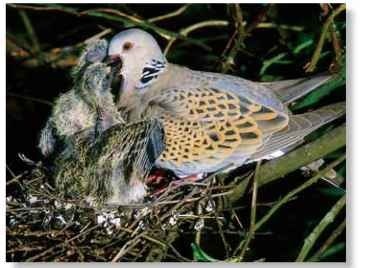ORDER
Columbiformes
FAMILY
Columbidae
GENUS & SPECIES
KEY FEATURES
• Coos a sweet but mournful mating call that is widely recognized
• Produces “pigeon milk,” a porridge like substance made only by doves and pigeons to feed their young
• Does not need to raise its head to swallow
WHERE IN THE WORLD?
Found throughout Europe, the Canary Islands, Egypt, northwest Africa, the central Sahara and western Siberia south to Kazakhstan

LIFECYCLE
Known as a symbol of love because of its tender mating song and faithfulness, the turtle dove is also a creature of habit: its daily feeding routine runs like clockwork.
HABITAT
A common inhabitant of open woodlands, the turtle dove frequents meadows that offer a smorgasbord of tasty seeds and leaves. Trees and bushes are used for roosting and nesting, while scattered weeds and grasses provide excellent feeding sites. The dove avoids windy, wet and chilly climates, instead preferring balmy weather for breeding. It settles in temperate, steppe and semidesert regions for mating and migrates south to the Mediterranean and
Africa for the winter.Whether in Europe,Asia or Africa, the dove’s home always has a source of water nearby.
Regular roost
The turtle dove roosts and nests in woodland trees.
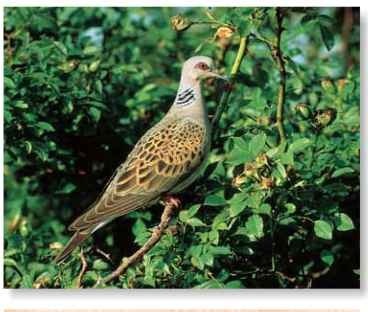
Doves are released at the Olympics to symbolize the hope of world peace, but in ancient times they were offered as a sacrifice.
Prolactin, a hormone formed in the anterior lobe of the pituitary gland, stimulates secretion of milk in both doves and mammals.
BREEDING
ALL IN THE FAMILY

Construction…
A turtle dove adds a grass lining to the flimsy straw and twig nest, which can be seen through from the ground below.
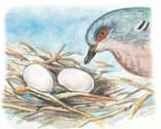
Inspection…
Before settling to incubate, the female dove examines the two white, smooth eggs, delicately placed in the nest.
FOOD & FEEDING
During its two daily feeding periods, the turtle dove also finds freshwater to drink. Its ability to suck up the water and swallow in one action is unusual among birds. Most birds have to raise their head to swallow, which often exposes them to predators.The turtle dove’s routine rarely changes. It wakes at dawn and hunts for a variety of tidbits, nibbling on staples of seeds, fruits and nuts, mainly on the ground. Each day at about midmorning the turtle dove retires to the nest to rest. In the afternoon it forages again, sampling leaves, cocoons of earthworms and the bird version of escargot small tree snails.
► Seed search With a fondness for weed seeds, a turtle dove finds food mainly on the ground.
Pairs of doves mate for life. After remaining in small flocks during the winter, they return each year to breeding areas in May. The male finds a nesting site, and both doves build a simple, fragile nest located 3-8′ above the ground in a tree or shrub. Varying their daily routine for a week, they spend early mornings and evenings shaping the nest.To begin his bowing display, an important part of courtship, the male stretches tall and then bows so low that his belly touches the branch or the ground. He repeats this movement up to six times in succession, at a rapid rate of less than 1 second per bow. One or two white oval eggs hatch within two weeks. Triggered by a hormone during incubation, the lining of both parents’ crops enlarge up to 20 times their original thickness.The parents feed only “pigeon milk” to the young for 5 days and then add grain to the porridge like mixture for about 18 more days.
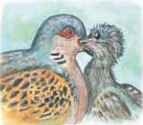
Regurgitation…
One squab appears to be engulfed by its parent, but is actually scooping up its first meal,”pigeon milk,” with its broad bill.
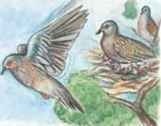
Aviation
Having spent almost 3 weeks in the nest, the two siblings are ready for their maiden flight.Their mother observes them closely.

BEHAVIOR
A break in the action A turtle dove takes time ol from feeding to sunbathe.
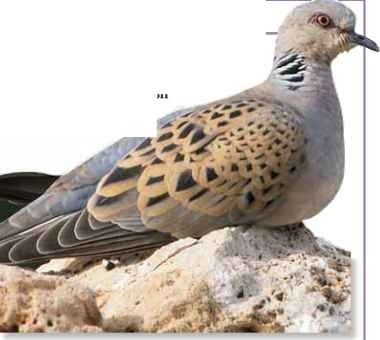
Male turtle doves take the lead in the chorus of turtle dove singing. A sad, tender cry, coorr-coorr, is sung by territorial males to females and potential male trespassers as a way of announcing their presence. The male turtle dove changes its tune, emitting a rapid croor-wa, croor-wa, croor-wa during its impressive courtship displays. Females are not quite as vocally talented as the males. Their coos, uttered less frequently, are usually hoarser and not as melodic as their male counterparts.
A smooth and elegant flier, the turtle dove travels long distances with easy wingbeats, frequently gliding. It maneuvers with finesse through foliage, instantly changing speed and direction. It takes off with a swift flutter and lands with tail feathers spread open. In flight, the dove uses its agility and speed to escape its aerial predators, such as hawks and eagles, but it prefers ducking for cover: Emitting a distress call that sounds much like a panting gasp, the turtle dove will even tr y to enter a building to escape. Often, after successful evasion, the dove will shake its head to express its discomfort at the close call.
CONSERVATION
Even though they are hunted by a variety of predators, turtle doves are resilient birds, and their populations remain strong. However, the passenger pigeon is a prime example of how an abundant bird can quickly become extinct. Prized for its meat and an easy target, it was hunted into oblivion at the turn of the 20th century.
PROFILE
Turtle Dove
The graceful turtle dove moves with agility in flight or on the ground and has one of the most specialized crops of all birds.
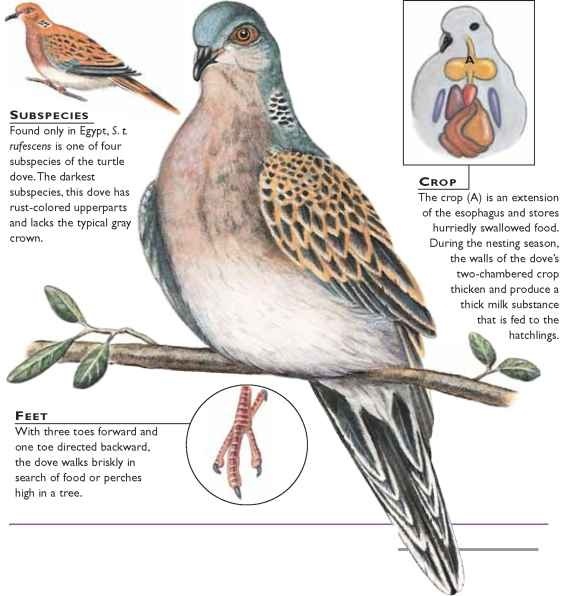
CREATURE COMPARISONS
The spinifex pigeon (Geophaps plumifera), at length, is slightly smaller than its close relative, the turtle dove. It gets its name from its Australian habitat of spinifex grassland, made up of plants with stiff and sharp-pointed leaves and seeds.The spinifex has a red-brown back, ail and wings, and resembles the turtle dove’s Egyptian subspecies, S. t. rufescens, in coloring.The two subspecies of the spinifex pigeon differ only by the color of their ibdomen: red-brown in one, white in the other
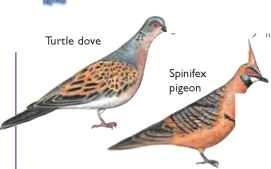
| VITAL Weight |
STATISTICS 3.5-5.5 oz. |
| Length | 10-10.6″ |
| Wingspan | 18.5-21″ |
| Sexual Maturity | 1 year |
| Breeding Season | Early May |
| Number of Eggs | 2 |
| Incubation PERIOD |
About 14 days |
| Fledging Period | 11-20 days |
| Breeding Interval | 1 year |
| Typical Diet | Seeds, fruits and nuts |
| Lifespan | Up to 13 years |
RELATED SPECIES
• “Pigeon” is the common name for members of a family of birds, Columbidae. Smaller species with pointed tails are known as doves, and larger species with round or square tails are usually referred to as pigeons, though the names are often used interchangeably. One of nearly 300 species, the ringed turtle dove, . Streptopelia risoria, belongs to the same genus as the turtle dove.

